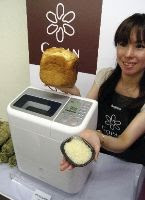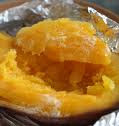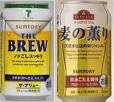[ . BACK to WORLDKIGO TOP . ]
::::::::::::::::::::::::::::::::::::::::::::::::::::::::::::::::::::::::::::::::::::::::::::::::::::
. Yosa Buson 与謝蕪村 in Edo .
was very fond of negi leek 葱 (nebuka) and also of
nira 韮 , Chinese garlic chives.
The translation is sometimes LEEK for both words.
冬ざれや小鳥のあさる韮畠
fuyuzare ya kotori no asaru nirabatake
withering plants in winter . . .
little birds search food
in the nira leek fields
Tr. Gabi Greve
Winter bareness--
Small birds foraging
Among the leeks.
trans. John M. Rosenfield
(in "Mynah Birds and Flying Rocks: Word and Image in the Art of Yosa Buson.")
Winter bareness--
little birds seeking food
in the patch of green onions.
trans. Sawa & Shiffert
Winter desolation;
Small birds fossicking*
In the scallion garden.
trans. Blyth
*fossicking: an unusual word, primarily used to mean prospecting for gold in Cornish English and Australian English. In the OED, the second meaning is: To rummage or hunt about; to search. And the third meaning is: To dig out, to hunt up (something).
Of the English words used to translate '
asaru':
"search," "seeking," "fossicking," and "foraging," I prefer "foraging." In fact, my Random House Japanese-English / English-Japanese Dictionary defines "asaru" as meaning: "rummage; forage; search for."
Larry Bole
Translating Haiku Forum
.................................................................................
ふゆざれや北の家陰(やかげ)の韮(にら)をかる
fuyuzare ya kita no yakage no nira o karu
Winter bareness;
in the north shadow of the house
cutting green onions.
trans. Sawa & Shiffert
. WASHOKU
Garlic chives, Chinese chives (nira)
:::::::::::::::::::::::::::::::::::::::::::::::::::::::::::::::::::::::::::::::::::::::::::::::::::::
葱買うて枯木の中を帰りけり
nebuka katte kareki no naka ni kaeri keri / nebuta koote (kaute)
I buy some leek
and then walk home
under bare trees . . .
Here Buson contrasts the brown dreary color of the withered trees and the fresh green he carries home to his wife and children for a delicious hot leek soup.
Tr. Gabi Greve
Buying leeks
and walking home
under the bare trees.
trans. Hass
negi koote kareki no naka o kaerekeri
Buying leeks
and then between withered trees
having returned.
trans. Sawa & Shiffert
:::::::::::::::::::::::::::::::::::::::::::::::::::::::::::::::::::::::::::::::::::::::::::::::::::::
うら町に葱うる声や宵の月
ura machi ni negi uru koe ya yoi no tsuki
in the nearby village
the voice of the leek sellers ...
moon of tonight
:::::::::::::::::::::::::::::::::::::::::::::::::::::::::::::::::::::::::::::::::::::::::::::::::::::
易水にねぶか流るる寒さかな
Ekisui ni nebuka nagaruru samusa kana
A leek,
Floating down the Ekisui,--
Ah, the cold!
Tr. Blyth
According to Blyth:
Keika, of the kingdom of En, who intended to kill King Shi, of the kingdom of Shin, 222-206 B.C., parted from Prince Tan, of En, at this river in North China. (He failed, and was himself killed).
Buson has taken this long, cold leek and put it in a place a thousand miles away, and at a time of two thousand years ago. What a long way to go to express the apparently simple sensations of whiteness and cold!
in the "Biographies of the Assassins" in Sima Qian's
"Records of the Grand Historian", where we find the famous verse,
易水歌
"風蕭蕭兮易水寒,壯士一去兮不復還!
The wind whistles and the River Yi runs cold
He'll never return again, this hero so bold!.
source : Jan Walls / facebook
The River Ekisui,
A leek is flowing;
How cold it is!
Tr. Tr. Shoji Kumano
The cut marker KANA is at the end of line 3.
along river Ekisui
a leek is floating down
in this cold . . .
Tr. Gabi Greve
. Buson and haiku about rivers .
:::::::::::::::::::::::::::::::::::::::::::::::::::::::::::::::::::::::::::::::::::::::::::::::::::::
腐儒者 韮 の羹 くらひけり
kusare jusha nira no atsumono kurai keri
Corrupt Confucian
Drank a brew of
Hot leek soup.
trans. Rosenfield
Rosenfield says of this haiku:
"...Buson employed the particularly harsh term 'kusare' (rotten, smelly, putrid, corrupt) to characterize a Confucian scholar...
"This hokku refers to an ancient ritual in which Confucians drank a certain kind of soup, but the verse was based on one by Du Fu that attacks false Confucians and not the presigious caste itself. Unflattering or ironic references to the Buddhist clergy appear in some of Buson's verses. More, however, contain expressions of piety and respect."
. WASHOKU
Garlic chives, Chinese chives (nira)
and more about the poor Confucian sholar
貧乏な儒者訪ひ来ぬる冬至哉
貧乏な 儒者とひ来(きた)る 冬至哉
binboo na jusha toi-kitaru tooji kana
a poor Confucian scholar
comes to visit
for the winter solstice . . .
Tr. Gabi Greve
The cut marker KANA is at the end of line 2.
. WKD : Confucius - Sekiten 釈奠 or Sekisai 釈菜 .
Neo-Confucianism in the Edo period
:::::::::::::::::::::::::::::::::::::::::::::::::::::::::::::::::::::::::::::::::::::::::::::::::::::
There is also a special ramen soup with extra leek in memory of Buson
Buson Raamen + negi 蕪村ラーメン+ねぎ
Buson Ramen
. . . CLICK here for Photos !
Buson-An sells
negi miso senbei 蕪村庵のねぎみそせんべい
rice crackers with Kujo negi

ねぎみそ煎餅
:::::::::::::::::::::::::::::::::::::::::::::::::::::::::::::::::::::::::::::::::::::::::::::::::::::
:::::::::::::::::::::::::::::::::::::::::::::::::::::::::::::::::::::::::::::::::::::::::::::::::::::
More Leek Haiku by Basho and others
葱白く洗ひたてたる寒さ哉
nebuka shiroku araiagetaru samusa kana
deep-rooted leeks
washed pure white:
so cold
trans. Barnhill
Barnhill's note:
Winter: onion; cold. 1691-92 (around the 10th of Tenth Month; November 29). Basho drew a painting of three leeks on a cutting board to accompany this hokku. The Tarui area, where this was written, was known for leeks with an underground stem that was white and up to a foot long ('nebuka' literally means "deep root").
Other translations of this haiku:
deep-rooted leeks
washed spotlessly white--
how cold!
Tr. Ueda
deep-rooted leeks
when finished washing
the coldness
Tr. Jane Reichhold
An exerpt from Reichhold's note:
[Basho] gave [the picture] to the Priest Kigai of Honryuuji Temple at Tarui in Mina Province.
The leeks
Newly washed white,--
How cold it is!
Tr. Blyth
Blyth's comment:
Even in summer the leeks would look cool, but in winter, after having been washed, they look like snowy icicles: This verse is not objective, as if written:
Washed,
How chill
The white leeks!
It is not subjective, as if written:
The white leeks
Washed,
How cold I am!
Basho feels himself to be a white leek, newly washed, and stood there next to the others. But he does not say anything as absurd as this, nor does he think it.
.................................................................................
白葱のひかりの棒をいま刻むを
shironegi no hikari no boo o ima kizamu
white leek
turned into light beam
now being cut up
Momoko Kuroda
Tr. Ueda
cutting
the white leeks
like shafts of light
translator unavailable to me
.................................................................................
negi sagete roojo boai ni hitorigoto
carrying leeks
an old woman in misty dusk
whispers to herself
Kayoko Hashimoto
Tr. Higginson
:::::::::::::::::::::::::::::::::::::::::::::::::::::::::::::::::::::::::::::::::::::::::::::::::::::
Matsuo Basho wrote
今朝の雪根深を園の枝折かな
kesa no yuki nebuka o sono no shiori kana
snow in the morning -
long leek are the signposts
in the vegetable garden
Matsuo Basho
at age 36
「根深」とは葱のこと。朝起きてみると大雪が積もっている。菜園のいたるところに雪が積もり、何処がどこだか分からない。そんな中にネギだけがちょこんと顔を出している。これが菜園の枝折のようだ。枝折は道しるべのこと。
source : itoyo/basho
After morning snow
onino shoots rise in the garden
like little singposts
reggeli hóban
csak a zöldhagymák
jelzik a kerti utat
. Reference .
A morning of snow
Only the onions in the garden
Blaze the trail
Tr. Jane Reichhold
facebook, march 2011
:::::::::::::::::::::::::::::::::::::::::::::::::::::::::::::::::::::::::::::::::::::::::::::::::::::
. WASHOKU
Negi, nebuka 葱 Leek
. WASHOKU
Garlic chives, Chinese chives 韮 nira
:::::::::::::::::::::::::::::::::::::::::::::::::::::::::::::::::::::::::::::::::::::::::::::::::::















































